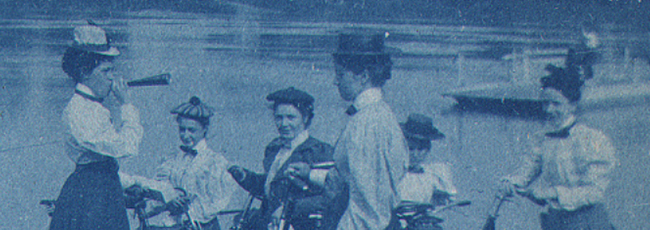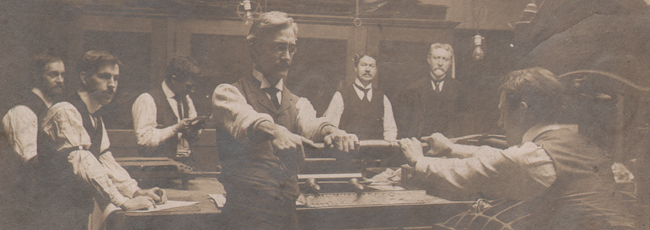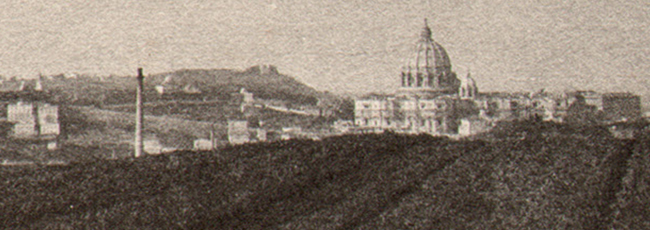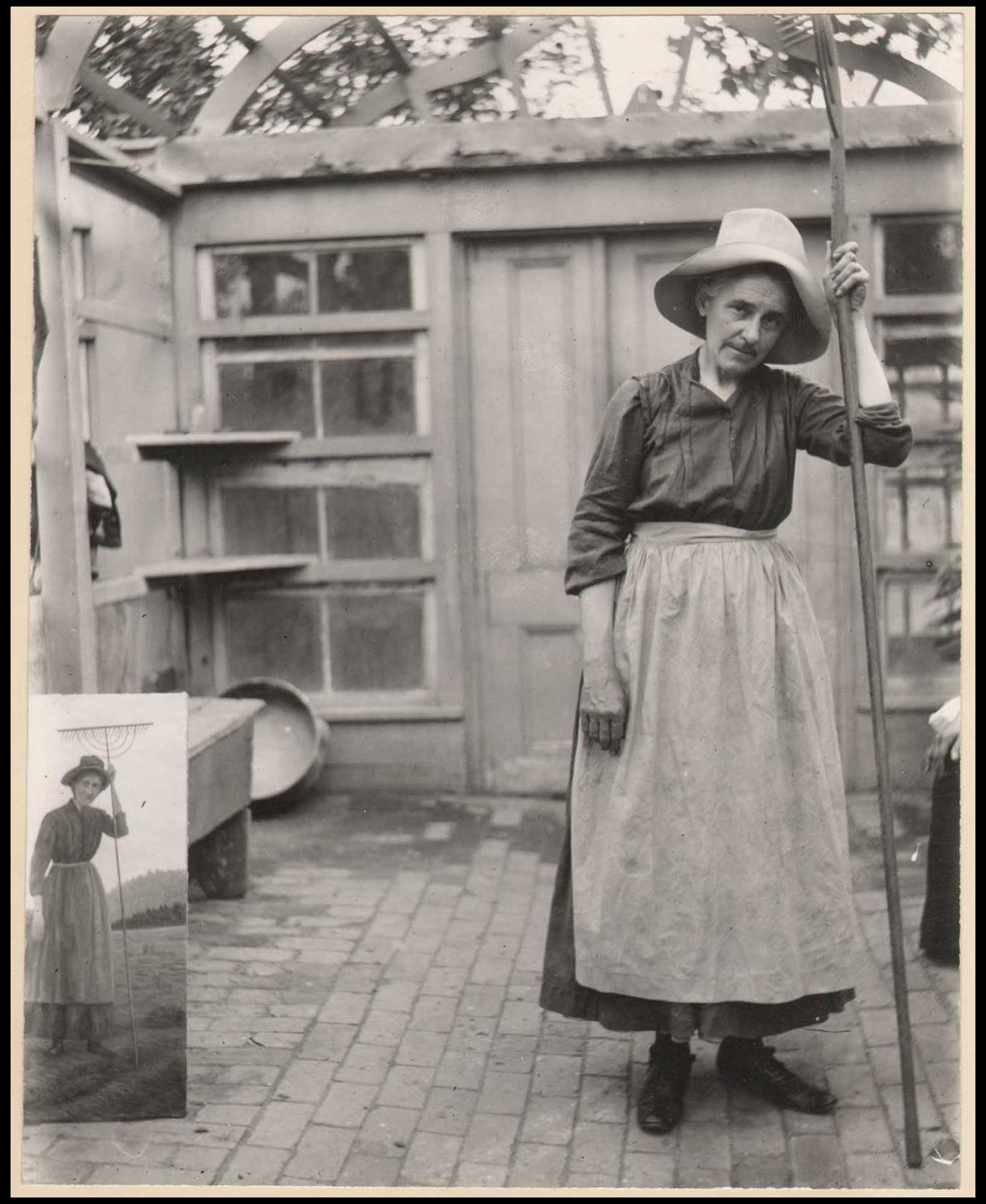
“Jeanette Bernard: Working Woman with Hay Rake”, Jeanette Bernard, American, 1855-1942. Gelatin silver, Ferrotyped press print, c. 1935-40 or before: believed to be from original glass plate negative c. 1910-20, 20.3 x 16.1 | 27.9 x 20.3 cm thin, manilla-colored cardstock. This fascinating portrait of the artist Jeanette Bernard, holding a long wooden hay rake, mimics a similar version of the subject’s pose with rake done on the painted panel at left. The location is beneath a pergola at her Queens, N.Y. home. From: PhotoSeed Archive
It’s one thing to think you could glean something about the personality of someone based on their photographs alone, but that’s how pictures often lie: especially for those souls who left anonymous work or whose backstory is lacking.
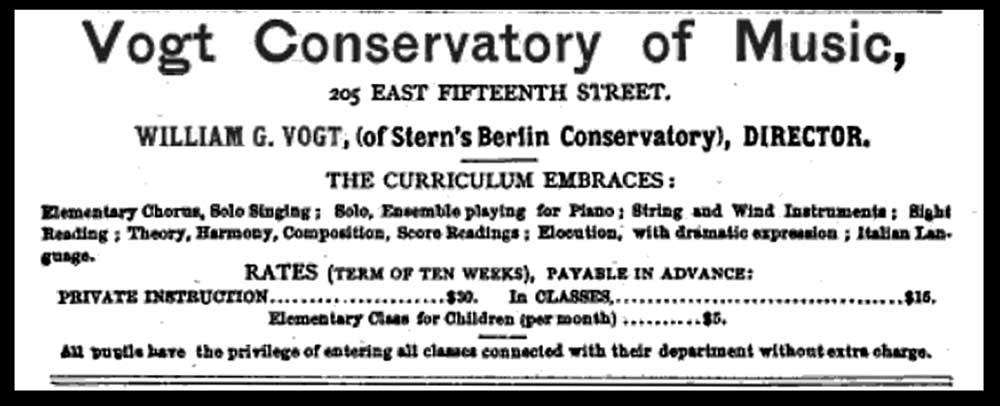
An early advertisement for the Vogt Conservatory of Music in the pages of the American Art Journal, November 8, 1879. A family business begun in early 1879, Jeanette (Vogt) Bernard was a professor of music at the conservatory, teaching elementary singing and piano. Digital image: The New York Public Library
Fortunately for us, today’s post gives a clearer definition for one whose artistic document of middle-class life in Queens, N.Y. at the turn of the 20th Century were the results of that amateur camera.

Nimble fingers for work and play: L: “Jeanette Bernard Playing the Piano”, R: “Jeanette Bernard Plucking a Goose”(cropped). Both: Jeanette Bernard, American, 1855-1942. Gelatin silver, Ferrotyped press prints, c. 1935-40 or before: believed to be from original glass plate negatives c. 1910-20, 19.7 x 14.5 cm & 16.3 x 11.4 cm. The artist, trained at the Stern Conservatory in Berlin, plays a “grand” style piano, most likely in her Queens, N.Y. home. At right, she takes part in the domestic dinner chores of plucking feathers from a goose or similar fowl while her terrier dog sits at her feet. Notice the tin bowl holding the removed feathers placed on the nearby table. From: PhotoSeed Archive
Jeanette Bernard, 1855-1942, is that soul, with an admirable assist from adopted daughter Minnie Fennel, 1880-1959, a photographer in her own right and likely artist behind some of the works from a small collection of about 25 vintage “press” prints by Bernard I’ve uploaded to the site
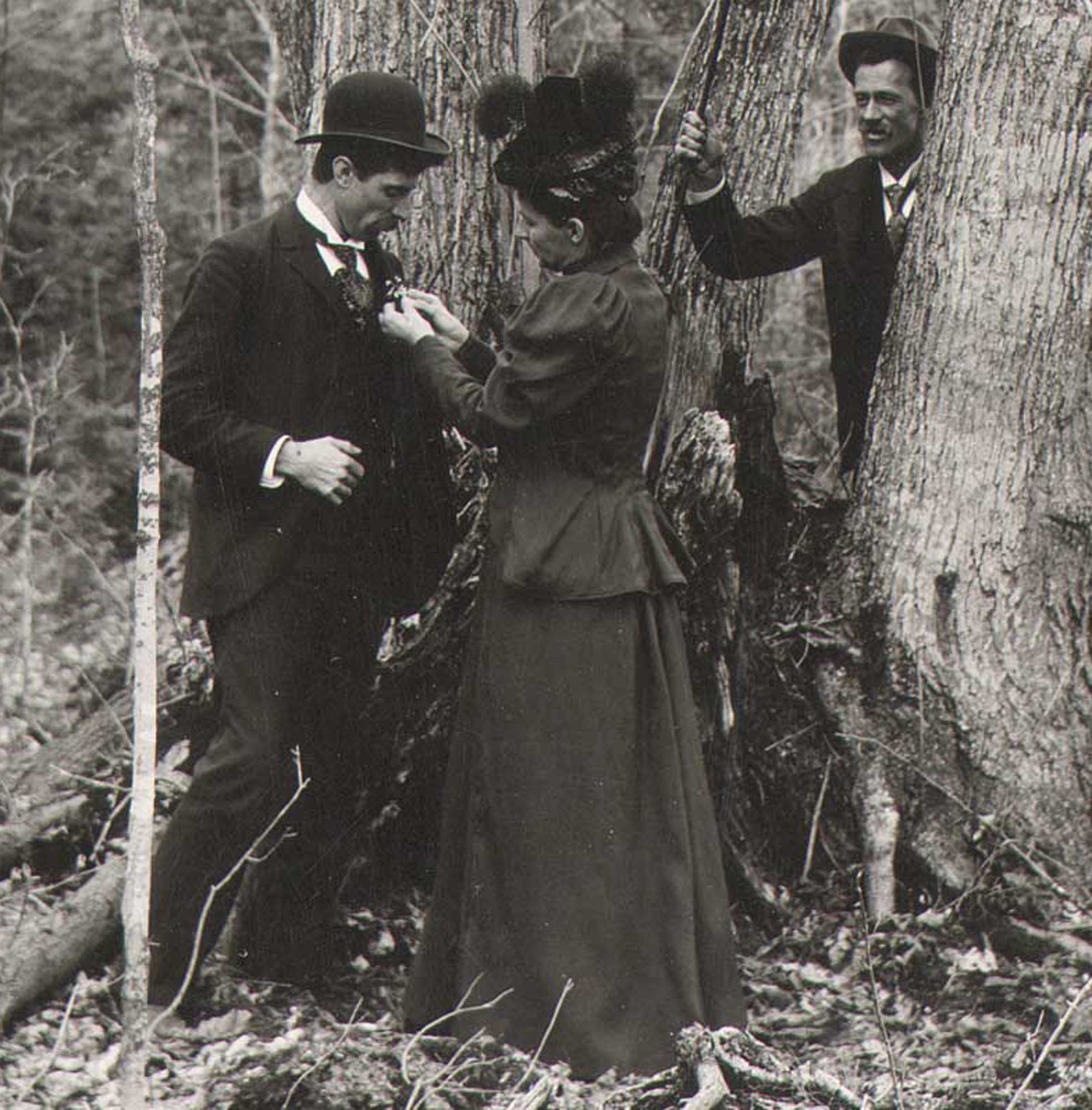
“A Surprise Tryst in the Woods” (cropped) Jeanette Bernard, American, 1855-1942. Gelatin silver, Ferrotyped press print, c. 1935-40 or before: believed to be from original glass plate negative c. 1905-10, 9.6 x 16.9 cm. An older gentleman, brandishing his walking stick from behind a large tree, confronts a woman and her beau caught in a tryst while she pins a floral boutonniere on his jacket. The couple might be Frank Keyser (b. 1873) and his future wife, Minnie Fennel, (b. 1880) the adopted daughter of the artist. From: PhotoSeed Archive
Five of these photographs feature Bernard as subject matter, and to my eye, she was no less than a force of nature, personality-wise. You can see this in a close-up of her playing the piano in her parlor, directing an intense and steady gaze upon the sheet music laid before her. And musical ability really did run her family. Due to research from this website, we discover that by the age of 24, her occupation was professor of music for the family concern: The Vogt Conservatory of Music, run out of the family home in New York City’s East Village. In an 1879 article, where it’s pointed out she was a graduate of the prestigious Berlin Conservatory in Germany, (known as the Stern Conservatory, which still exists) her job at the Vogt Conservatory was described thus:
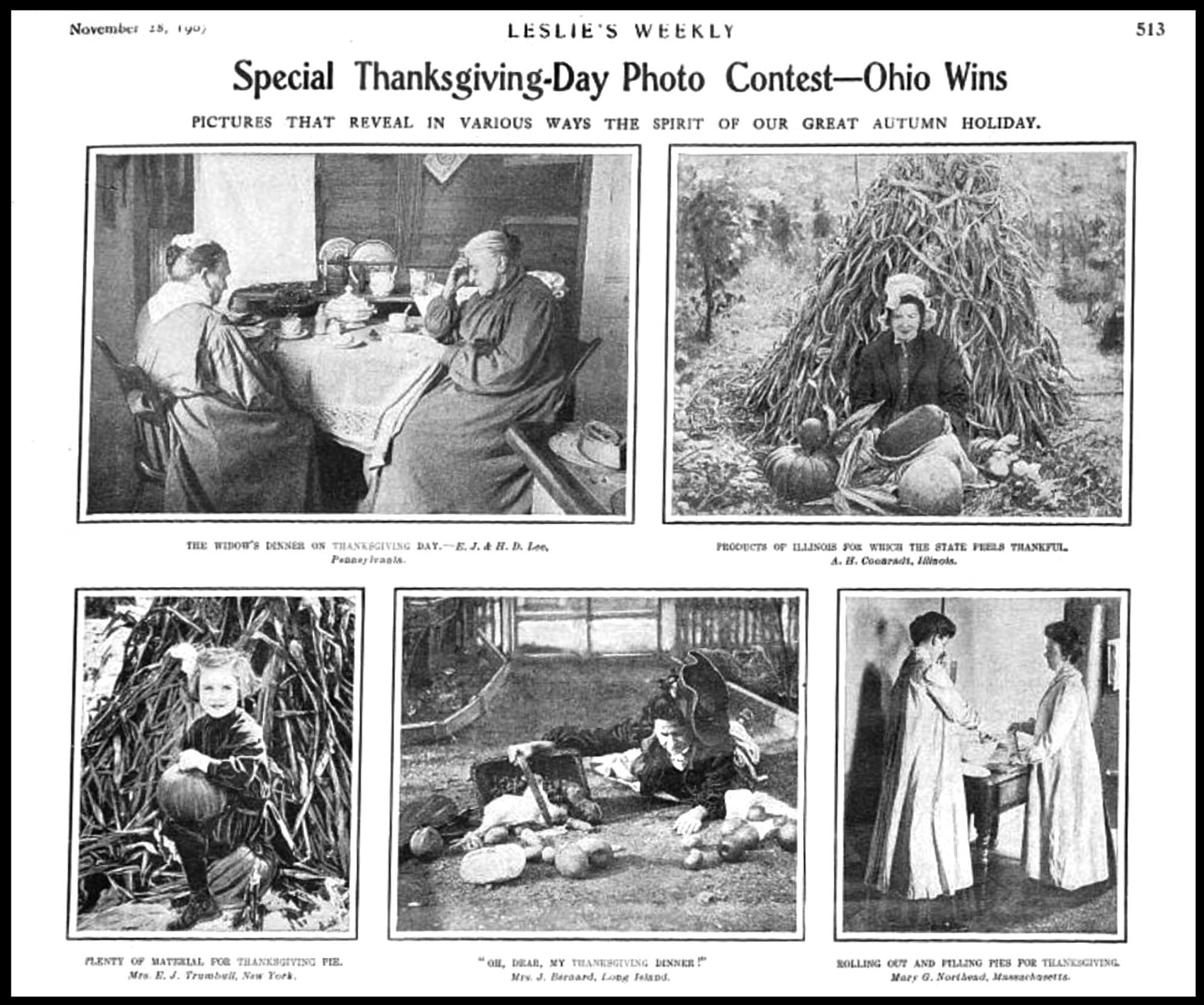
Jeanette Bernard’s 1907 comical view, “Oh, Dear, My Thanksgiving Dinner!” was published along with other prize-winning photographs in (Frank) Leslie’s Weekly on November 28, 1907. This cropped view of the magazine page shows the photo- featuring daughter Minnie Fennel- sprawled on the ground outside their Long Island home. (bottom row, middle) The photograph appeared as part of a monthly contest: Special Thanksgiving-Day Photo Contest- Ohio Wins: Pictures that reveal in various ways the spirit of our great Autumn Holiday. Digital image: The University of Texas
“Elementary singing and piano are taught by Miss Jeanette Vogt, a graduate of the Berlin Conservatory. The lady’s public performances as pianiste won her much critical commendation for her musicianly attainments.”
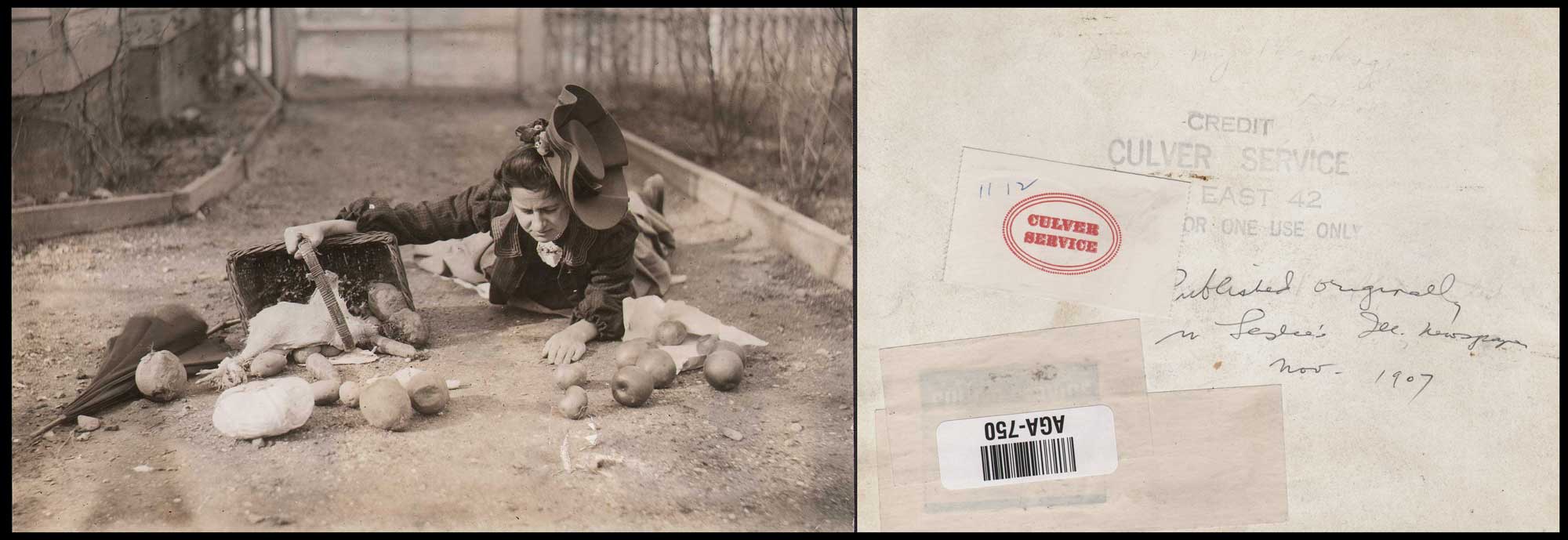
Recto & Verso: L: “Oh, Dear, My Thanksgiving Dinner!” (slight crop) Jeanette Bernard, American, 1855-1942. 1907, gelatin silver, ferrotyped press print, c. 1935-40 or before: believed to be from original glass plate negative c. 1907, 15.6 x 20.0 cm. R: The backside, like all the Bernard prints in this archive, feature a miscellany of Culver Service stamps and stickers like this example, which also gives a publishing history annotated in ink: “Published originally in Leslie’s Ill(ustrated) Newspaper Nov. 1907” From: PhotoSeed Archive
So music was one spoke of her wheel. How about the subject of love and romance? You can see those in her photo of daughter Minnie and husband (or soon-to-be) Frank Keyser gazing into each others eyes, or something completely unexpected: a tryst in the woods gone wrong, with a man waving his cane from behind a tree to interrupt the moment for a courting couple. In terms of a multi-dimensional personality, lets also consider her droll sense of humor.
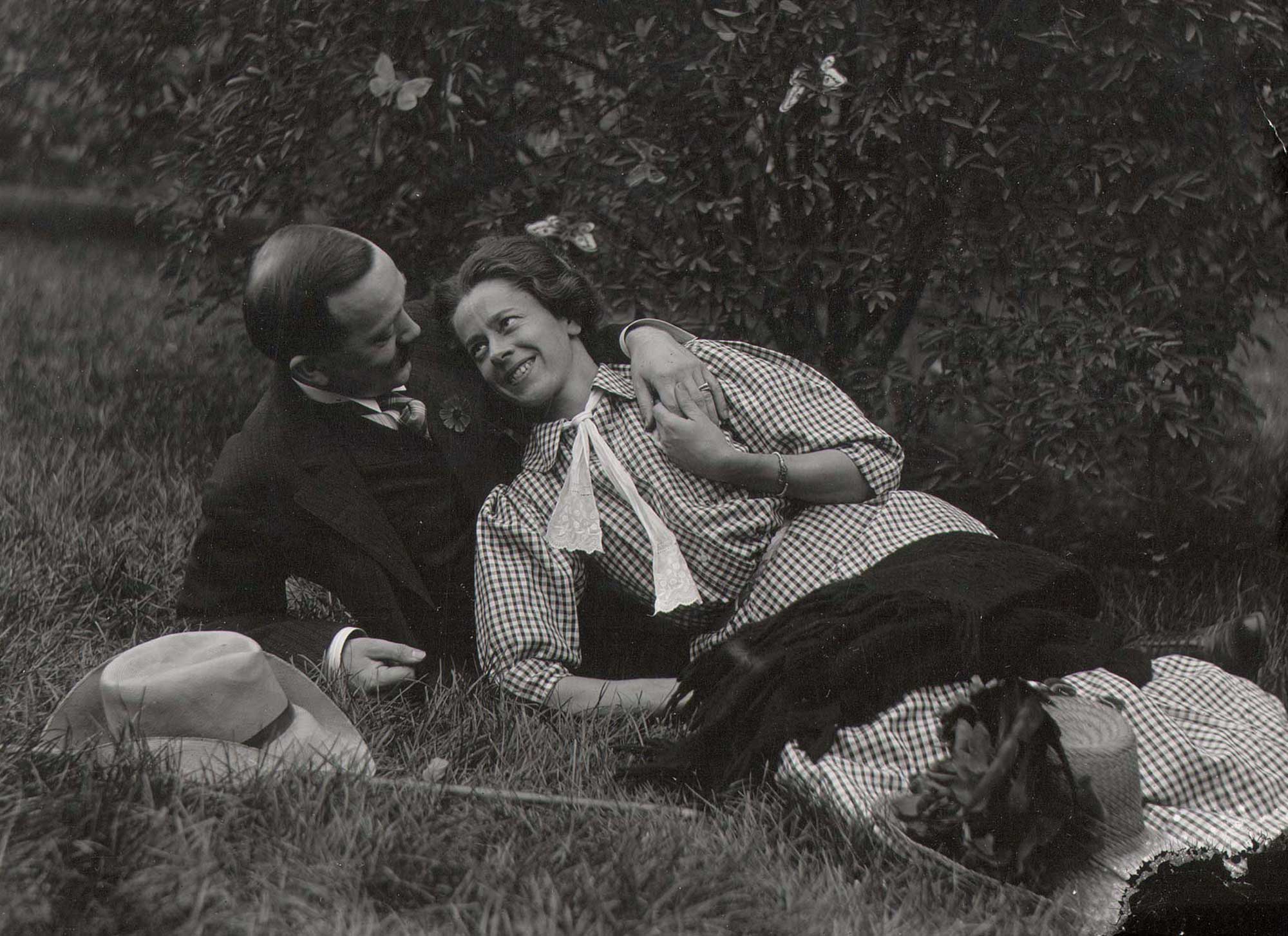
“The Lovers: Minnie Fennel & Frank Keyser” (slight crop), Jeanette Bernard, American, 1855-1942. Gelatin silver, Ferrotyped press print, c. 1935-40 or before: believed to be from original glass plate negative c. 1905-10, 14.1 x 18.7 cm. Laying in the grass and gazing into each others eyes: a study of young love by the artist. The subjects are believed to be Frank Keyser (b. 1873) and Minnie Fennel, (b. 1880) his young bride, or soon to be betrothed. Fennel was the adopted daughter of the artist. Can you spot the butterflies arranged in the leaves behind the couple? From: PhotoSeed Archive
Look no further than a study of the artist-probably taken by daughter Minnie- where she sports a large floppy hat while holding a wood hay rake by her side. But what’s that painting next to her? A study of the photographer herself, standing in similar repose. Life imitating art? Art imitating life? Both could arguably apply to this New Yorker who seemingly had the gift of self-deprecation while channeling her own inner reality. For this is a life lived in the moment, and one (momentarily) uncorrupted by the omnipresent social mores which hindered women navigating modern society- even accomplished women like Bernard- a full 70 years before an artist like Cindy Sherman would come along with an update. Sherman’s leap would call out the obvious, with its’ famous photographic self-tropes in Untitled Film Stills fueling the deconstruction of female stereotypes.
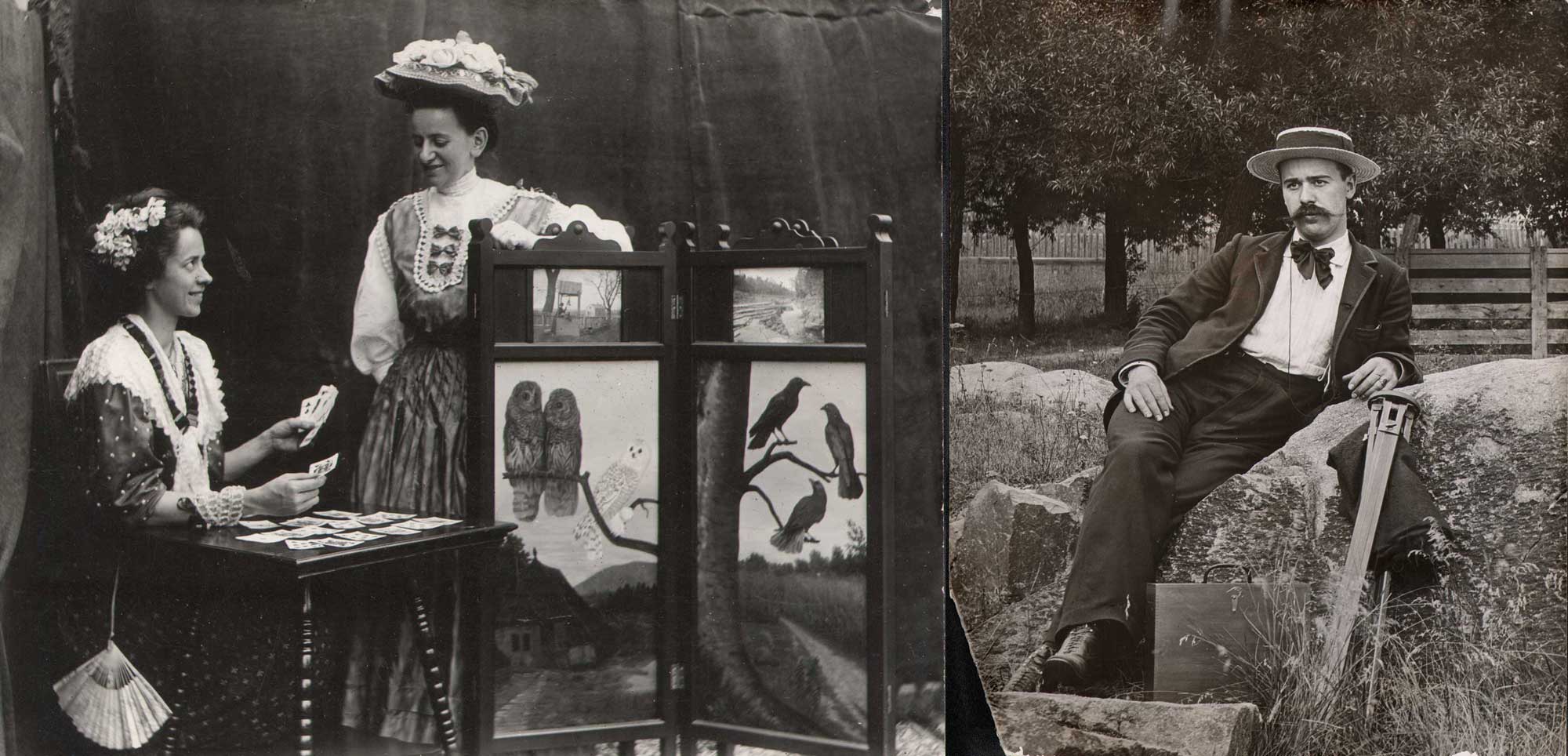
L: “Minnie Fennel as Fortune Teller”, R: “Frank Keyser with Pochade Artists Box and Tripod”, both: Jeanette Bernard, American, 1855-1942. Gelatin silver, ferrotyped press prints, c. 1935-40 or before: believed to be from original glass plate negatives c. 1910-20 & 1900-10: 14.2 x 17.7 cm & 22.4 x 18.1 cm. Minnie Fennel, (b. 1880) the adopted daughter of the artist, plays the role of fortune teller while holding playing cards, with the screen at right featuring artwork, possibly by husband Frank Keyser with photographs inset at top by Jeanette Bernard. R: Keyser poses next to a pochade box at his feet used by plein air (outdoors-in the open air) artists. From: PhotoSeed Archive
Another words, if you think something hasn’t been done in photography before, maybe think again. But that’s not all. Besides being someone naturally creative in the arts, Jeanette Bernard should be admired for her work ethic. Take a gander, of all things, while she patiently plucks the feathers from a goose or other bird of fowl while preparing the family meal. Her trusty terrier by her side, she has come prepared. Dressed warmly with a head covering and lap apron, those feathers mounded in the tin wash basin set before her will surely not to be wasted. Comfortable pillows or other domestic necessities are but one possible outcome for Bernard, whose thrift kept middle class families like hers solvent and well fed 125 years ago.
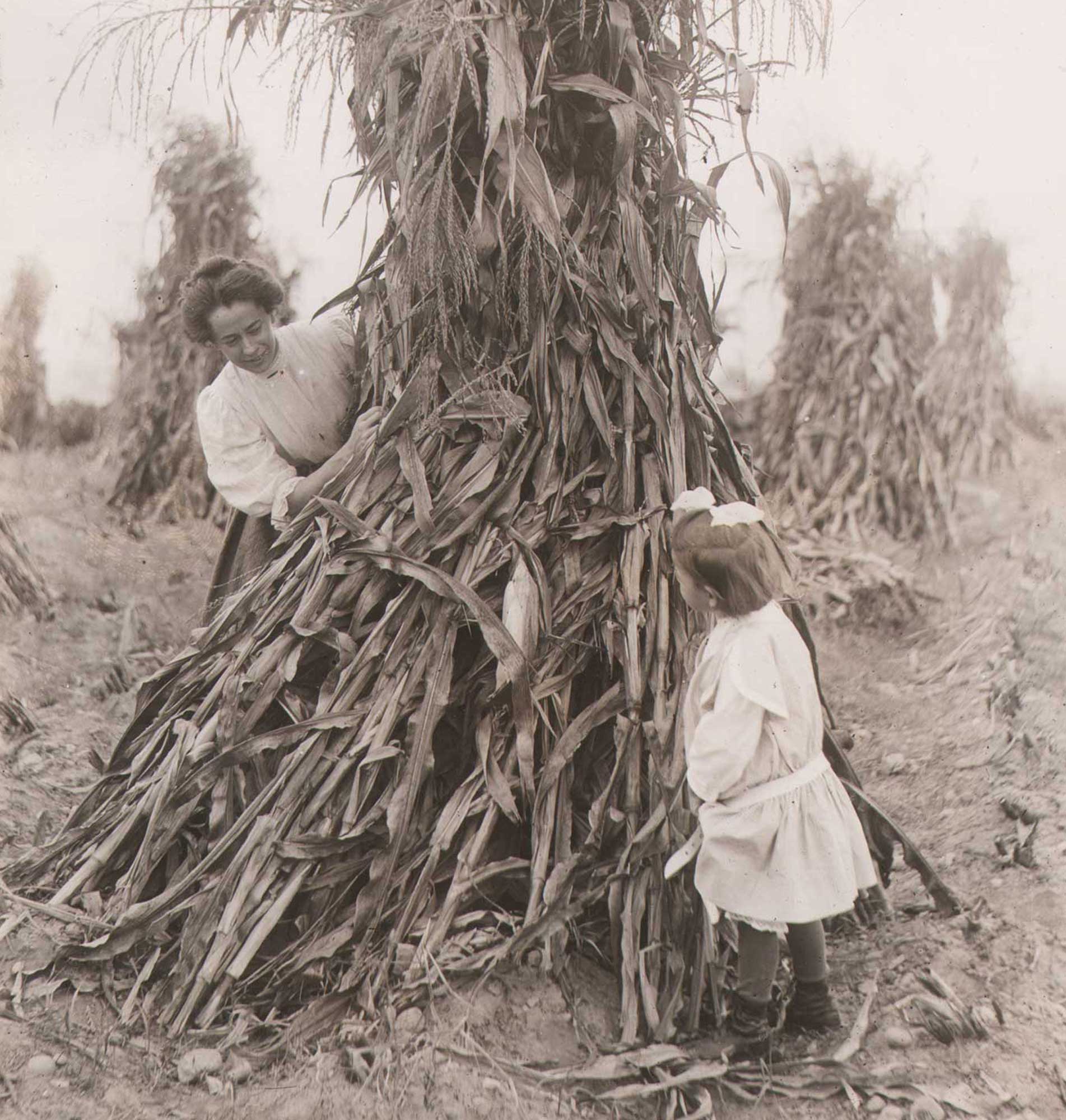
“Corn Shock: Minnie Keyser & Daughter Emma” (slight crop), Jeanette Bernard, American, 1855-1942. Gelatin silver, ferrotyped press print, c. 1935-40 or before: believed to be from original glass plate negative c. 1910-15, 19.9 x 14.2 cm. In a harvested Fall cornfield, the artist’s adopted daughter, Minnie Fennel, (b. 1880) peeks from behind a large shock of corn at a young child, believed to be her daughter Emma Keyser. (b. 1910) Writing on the verso of the photograph states: Mrs Bernard’s daughter again Corn – but “good corn”. From: PhotoSeed Archive
I had initially learned of Bernard’s work about 15 years ago, when Jami Guthrie of Ryerson University & George Eastman House published her thesis: “Jeanette Bernard And American Amateur Photography Contests In The Early Twentieth Century”. Three years later, in late 2013, writer Ron Marzlock contributed more details through his article on the photographer and her neighborhood for the Queens Chronicle newspaper.
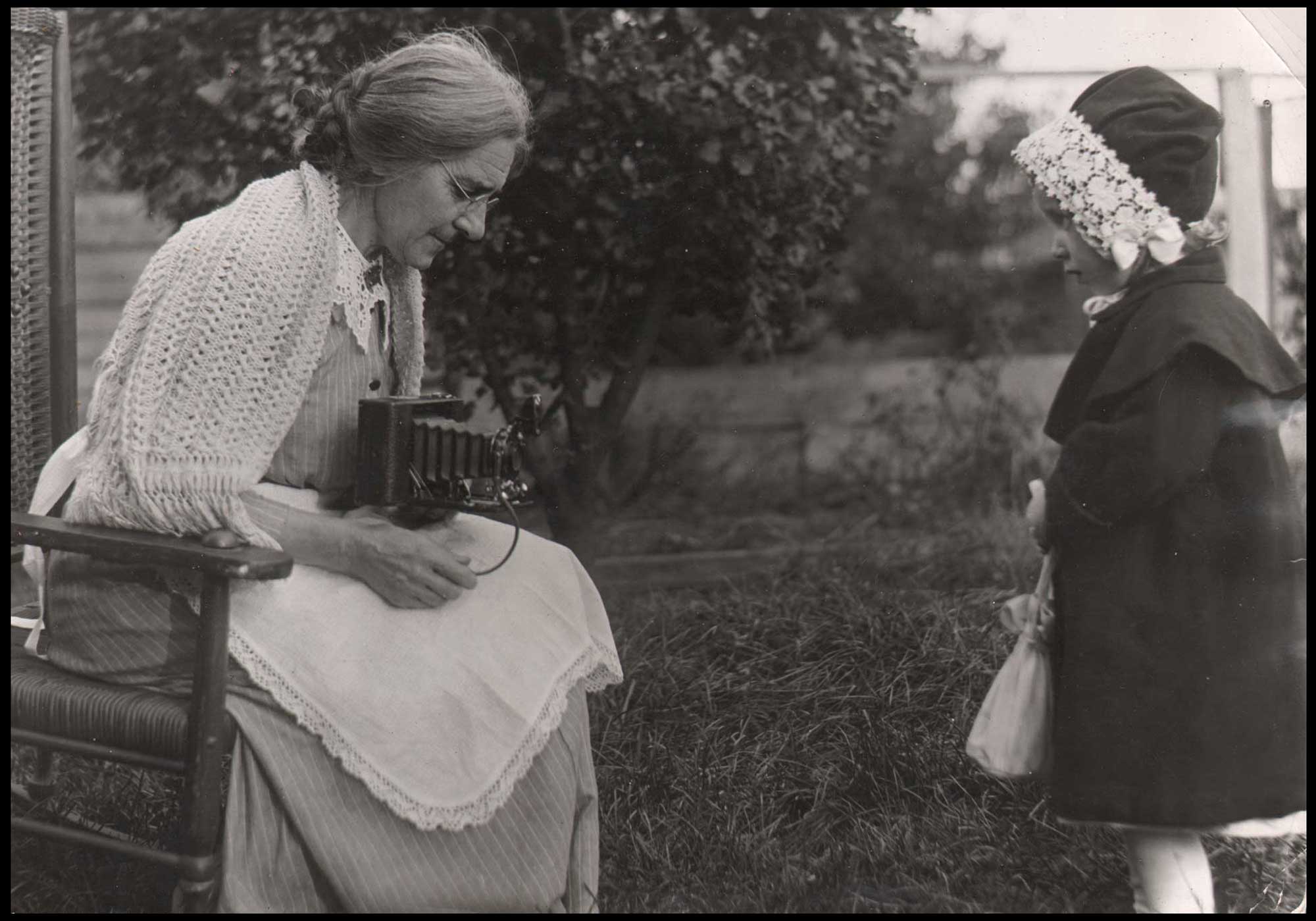
“Jeanette Bernard Taking Photograph of Child” Jeanette Bernard, American, 1855-1942. Gelatin silver, ferrotyped press print, c. 1935-40 or before: believed to be from original glass plate negative c. 1910-20, 17.1 x 24.6 cm. The artist takes a photograph of a young girl (perhaps the artist’s granddaughter Emma Keyser) dressed in an outfit recalling the folktale character Little Red Riding Hood. She uses a camera that may be from the Eastman Kodak Company’s Folding Pocket Brownie series- perhaps the model 3-A, made 1909-1915, or an earlier model 3, made 1905-15. From: PhotoSeed Archive
Both finally gave the artist some long overdue recognition, and it’s hoped our own scholarship fills in some of the biographical gaps of the remarkable life of Jeanette Bernard while pulling you into her orbit: one in which her wonderfully humane photographs provide the keystone to her unique personality, which now can shine through a bit brighter.
